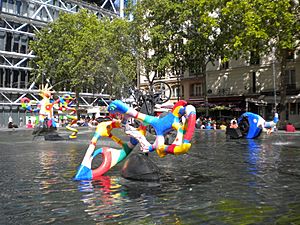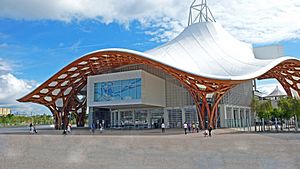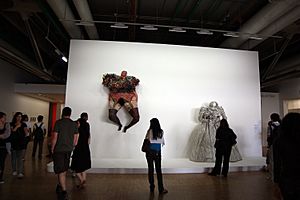Centre Pompidou facts for kids
Quick facts for kids Centre Georges Pompidou |
|
|---|---|
 |
|
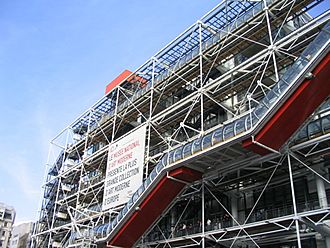 |
|
| General information | |
| Type | Cultural center |
| Architectural style | Postmodern / high-tech |
| Location | Paris, France |
| Completed | 1971–1977 |
| Technical details | |
| Structural system | Steel superstructure with reinforced concrete floors |
| Design and construction | |
| Architect | Renzo Piano, Richard Rogers, and Gianfranco Franchini |
| Structural engineer | Arup |
| Services engineer | Arup |
The Centre Pompidou (French pronunciation: [sɑ̃tʁ pɔ̃pidu]), also known as the Pompidou Centre or Beaubourg, is a famous building in Paris, France. It was designed by architects Richard Rogers, Su Rogers, Renzo Piano, and Gianfranco Franchini. The building is named after Georges Pompidou, who was the President of France from 1969 to 1974 and asked for the building to be built. It officially opened on 31 January 1977.
The Centre Pompidou is located in the Beaubourg area of the 4th arrondissement of Paris. It is home to a huge public library called the Bibliothèque publique d'information (BPI). It also houses the Musée National d'Art Moderne, which is the biggest museum for modern art in Europe. Another part of the center is IRCAM, a special place for music and sound research. In front of the museum, there is an open area called the Place Georges Pompidou.
The Centre Pompidou closed for major renovations on 1 July 2025 and will reopen in 2030. The BPI will temporarily move to its Lumière building on 25 August 2025.
History of the Centre Pompidou
How the Idea Started
The idea for the Centre Pompidou came from André Malraux, France's first Minister of Cultural Affairs. He believed that art and culture should be available to everyone, not just in one main city. In the 1960s, city planners in Paris decided to move the old food markets from Les Halles. They thought some cultural places could be built in that area. There was also a need for a large, free public library in Paris, as one didn't exist then.
In 1968, President Charles de Gaulle announced that a place called Plateau Beaubourg would be the new spot for the library. Then, in 1969, the new president, Georges Pompidou, decided that this location would be home to both the new library and a center for modern arts. The IRCAM (a music research institute) was also added to the plan.
Choosing the Design
An international competition was held to pick the best design for the new center. Architects Oscar Niemeyer, Jean Prouvé, and Philip Johnson were on the judging panel. It was the first time France allowed architects from all over the world to enter such a competition.
The design by Richard Rogers and Renzo Piano was chosen from 681 entries. This decision was announced in 1971. Their choice showed a mix of new, bold architecture and traditional government ideas.
Renovations and Global Plans
A big renovation project started in 2025 and will continue until 2030. The Centre Pompidou closed its doors on 2 March 2025. The BPI, the public library, will temporarily move to its Lumière building on 25 August 2025.
While the main building is being renovated, the Centre Pompidou is also expanding around the world. Its first location in South America is planned to open in Foz do Iguaçu, Brazil, in November 2027. The Centre Pompidou also plans to open new locations in other places like Shanghai and Málaga.
Architecture and Design
Unique "Inside-Out" Look
Richard Rogers and Renzo Piano were young architects when they designed the Centre Pompidou. They created a very unusual "inside-out" building. This means that the building's structure, pipes, and escalators are all on the outside. They believed this would make the inside space more flexible and open for art. Gianfranco Franchini also helped with the design.
Renzo Piano explained their idea: "Our idea was a museum that would inspire curiosity, not intimidate people, and that would open up culture to all." They wanted it to be a place for everyone, no matter their background.
The design made the inside of the building very efficient. All the different functional parts on the outside were given specific colors:
- Green pipes are for plumbing (water).
- Blue ducts are for climate control (heating and cooling).
- Yellow wires are for electrical systems.
- Red elements are for moving around (like escalators) and safety (like fire extinguishers).
Piano described the building as "not a building but a town where you find everything – lunch, great art, a library, great music."
When it first opened, some people didn't like the design, much like how people first reacted to the Eiffel Tower. But over time, the Centre Pompidou became seen as a work of art itself. National Geographic called the public's reaction "love at second sight." In 2007, when Richard Rogers won the Pritzker Prize (a top award for architects), The New York Times said the Centre's design "turned the architecture world upside down." The Pritzker jury also said the Pompidou "revolutionised museums, transforming what had once been elite monuments into popular places of social and cultural exchange."
Building the Centre
The Centre Pompidou was built by GTM and finished in 1977. The main engineer was Peter Rice. From October 1996 to January 2000, the center underwent renovations and was closed to the public for 27 months. It reopened on 1 January 2000.
In September 2020, it was announced that the Centre Pompidou would begin more renovations in 2023. These renovations started in 2025 and will require a full closure until 2030. The estimated cost for these renovations is $235 million.
What's Inside and Outside
The Centre Pompidou is often called Beaubourg by locals because of its location in the Beaubourg area of Paris.
Inside the Centre
The Centre Pompidou is home to three main parts:
- The Bibliothèque publique d'information (Bpi), a very large public library.
- The Musée National d'Art Moderne, which is the biggest museum in Europe for modern and contemporary art.
- IRCAM, a special center for music and sound research.
The BPI has about 367,000 books, plus magazines, videos, photos, and many other materials. Anyone can use the collections, but you can't borrow items to take home. The library also hosts cultural events and shows documentary films, including the Cinéma du Réel documentary film festival.
As mentioned, the BPI will temporarily move to its Lumière building on 25 August 2025, while the main Centre Pompidou is being renovated.
Outside the Centre
In 2012, a large sculpture called Horizontal by Alexander Calder was placed in front of the Centre Pompidou. It's a mobile sculpture that stands 7.6 m (25 ft) tall.
Stravinsky Fountain
Near the Centre Pompidou is the Stravinsky Fountain, also known as the Fontaine des automates. This fountain has 16 fun, moving sculptures that spray water. They were created by Jean Tinguely and Niki de Saint-Phalle and represent ideas and music by the composer Igor Stravinsky. Tinguely made the black mechanical sculptures, and de Saint-Phalle made the colorful ones. The fountain opened in 1983.
Place Georges Pompidou
The open area in front of the museum, called Place Georges Pompidou, is famous for its street performers. You can often see mimes and jugglers there. In the spring, small carnivals are sometimes set up with bands, caricature artists, and even skateboarding competitions.
In 2021, artists Arotin & Serghei created a large art installation called Infinite Light Columns / Constellations of The Future for the reopening of the Place Georges Pompidou. It was placed near Piano's IRCAM Tower.
Visitors and Popularity
The Centre Pompidou was originally designed to handle about 8,000 visitors a day. However, it became much more popular than expected! In its first two decades, it welcomed over 145 million visitors, which was more than five times the original prediction. By 2006, over 180 million people had visited the center since it opened in 1977.
Before the renovation from 1997 to 2000, many visitors, especially tourists, would ride the escalators on the outside of the building just to see the views from the top. The renovation improved how easy it was for visitors to get around the center.
In 2013, the center had over 5.2 million visitors. The museum alone had nearly 3.75 million visitors that year. A special exhibition about the artist Dalí in 2013 broke the museum's daily attendance record, with 7,364 people visiting each day.
In 2022, the center had 3.1 million visitors. This was a big increase from 2021, but still lower than before the COVID-19 pandemic in France caused closures.
Expanding the Centre Pompidou
Branches in France
In 2010, the Centre Georges Pompidou opened a branch called the Centre Pompidou-Metz in Metz, a city about 250 kilometers east of Paris. This new museum helps share modern art beyond Paris. The building was designed by architect Shigeru Ban and has a unique, curving roof. Its 77-meter central spire is a nod to 1977, the year the main Centre Pompidou in Paris was built. The Centre Pompidou-Metz shows special, temporary exhibitions from the collection of the Musée National d'Art Moderne.
Since it opened, the Centre Pompidou-Metz has become the most visited cultural place in France outside of Paris, with 550,000 visitors each year.
In 2014, there were plans for a temporary Centre Pompidou location in Maubeuge, a town near the Belgian border. This outpost was planned to be in a 17th-century building for four years. In 2019, the Centre Pompidou also announced plans for a large conservation, exhibition, and storage space in Massy by 2025.
International Expansion
Europe
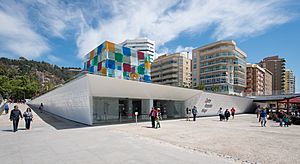
Málaga
In 2015, about 70 artworks from the Centre Pompidou's collection were put on display in a special glass building called The Cube (El Cubo) in Málaga, Spain. This partnership was planned for five years and has been renewed several times. The latest agreement means the city of Málaga will pay the Centre Pompidou an annual fee for the next ten years (2025–2034).
The Málaga location shows about 100 works from the Pompidou's 20th and 21st-century collection. It also has a smaller area for temporary exhibitions. Famous artists like Alberto Giacometti, René Magritte, and Alexander Calder have works displayed there.
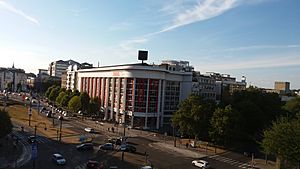
Brussels
In March 2018, the Centre Pompidou announced plans for a branch in Brussels, Belgium, called KANAL - Centre Pompidou. It is located in a former Citroën car garage. This new center brings together a Museum of Modern and Contemporary Art, an architecture center, and public spaces for culture and education.
Asia
In 2019, the Centre Pompidou x West Bund Museum opened in Shanghai, China. It is located in a wing of the West Bund Art Museum. The first exhibitions there showed highlights from the Centre Pompidou's collection of modern art and new media.
North America
A satellite museum called Centre Pompidou x Jersey City in Jersey City, New Jersey, was planned to open in 2024. This would have been the Pompidou's first satellite museum in North America. However, in 2024, funding for the museum was withdrawn. The Jersey City City Council later approved a plan for the museum to open at a different location.
South America
As mentioned earlier, there are plans for a pop-up Pompidou satellite museum in Brazil. This location in Foz do Iguaçu is scheduled to open in November 2027.
Management and Funding
Presidents
The Centre Pompidou has had several presidents since it was founded:
- 2021 – present: Laurent Le Bon
- 2015 – 2021: Serge Lasvignes
- 2007 – 2015: Alain Seban
- 2002 – 2007: Bruno Racine
- 1996 – 2002: Jean-Jacques Aillagon
- 1993 – 1996: François Barré
- 1991 – 1993: Dominique Bozo
- 1989 – 1991: Hélène Ahrweiler
- 1983 – 1989: Jean Maheu
- 1980 – 1983: Jean-Claude Groshens
- 1977 – 1980: Jean Millier
- 1976 – 1977: Robert Bordaz
- 1969 – 1977: Georges Pompidou
How it's Funded
As a national museum, the Centre Pompidou is owned by the government and gets money from the Ministry of Culture. This money mainly covers staff salaries. The Culture Ministry appoints its directors, but the center manages itself.
The Georges Pompidou Art and Culture Foundation is a group in the US that helps the museum by getting donations of art and design. Since 2006, this group has helped the museum receive 28 artworks worth over $14 million. In 2013, art collectors Thea Westreich Wagner and Ethan Wagner announced they would donate about 300 works by different artists to the Centre Pompidou, making it one of the biggest gifts in the museum's history.
Art with Difficult Histories
Sometimes, museums find out that artworks in their collection were taken unfairly, especially during wars. The Centre Pompidou has worked to address these issues. For example, in 2011, it admitted that it held three paintings by artist Fédor Löwenstein that had been taken during the Nazi occupation of France. In 2021, after the French government returned a painting by Max Pechstein to the family it was taken from, the Centre Pompidou held an exhibition to honor the art collector who had been persecuted.
Getting There
You can reach the Centre Pompidou using public transport:
- Nearby Métro stations: Rambuteau, Les Halles
- RER train: Châtelet – Les Halles
Exhibitions
The Centre Pompidou hosts several major exhibitions each year. These can be about a single artist (monographs) or feature works by many artists (group exhibitions).
Some past group exhibitions have included:
- Photography as a weapon of class (2018)
- Coder le monde (2018)
- La Fabrique Du Vivant (2019)
- Jo-Ey Tang & Thomas Fougeirol – Dust. The Plates Of The Present (2020)
- Les Moyens Du Bord (2020)
- Global(e) Resistance – Pour une histoire engagée de la collection contemporaine de Jonathas de Andrade à Billie Zangewa (2020)
- NEURONS Simulated intelligence (2020)
- L'écologie des images (2021)
See also
 In Spanish: Centro Pompidou para niños
In Spanish: Centro Pompidou para niños
- List of museums in Paris
- List of tourist attractions in Paris



